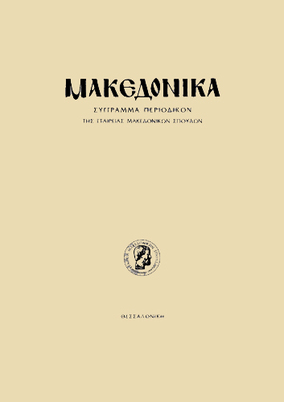Το Οθωμανικό λουτρό της αγοράς Yahudi Hamami (Λουλουδάδικα) της Θεσσαλονίκης
Part of : Μακεδονικά ; Vol.27, 1989, pages 79-120
Issue:
Pages:
79-120
Parallel Title:
The Ottoman Bath of the Market Jahudi-Hamami («Λουλουδάδικα») of Thessaloniki
Section Title:
Articles
Abstract:
The large Ottoman Bath of the Market (Pazar i Kebir Hamami) in the Jewish and mainly commercial area (until the fire of 1917) of Thessaloniki, is one of the few Ottoman public buildings — dedications which survived to our day.It is mentioned for the first time by Evlija Tzelebi (mid 17 C) as Ha- lilaga Hamami — at least as far as we can know today — while in the Historical Archives of Macedonia it seems to change often its name.Its architecture and building mode place it close to the large baths of the classical period of the Ottoman architecture (1453-1603) in the region of Constantinople. It has striking conceptional similarities with the Meram Hamami in Konya (1423), the Mahmut Pasha Hamami in Constantinople (1466), the Beyazit-Hamami (1481-1512), the Edirnekapi or Mihrimah-Hamami (1548) by the architect Sinan or the Cukur Hamami (15 C), all in the same town. Equally typical relations we find between the Jahudi, or Pazar Hamami of Thessaloniki and the large hamams of the same period in the South Balkan Peninsula like for example the Davudpasa Hamami in Skopje (15C). It is worth noticing that in the same period we have a series of remarkable large buildings in Thessaloniki-naturally after its capture in 1430, like the Bey Hamami (1444) the Hamza Bey Carni (1467), the Bezesten, (1465-69) to mention few of those still preserved.In this study it is described the architecture of the monument in detail, its condition, its substructure and its decorative elements (plaster-reliefs and paintings) while particular emphasis is given to the description of its construction (hypocausts in its substructure, arches-cupolas in the upper construction) and the materials and ways of building. Also some historical elements are given after research in archives and a typological classification and a chronological establishing is attempted in the 16C, taking into consideration all the above. This is supported by the fact that the building was the only one situated in the center of the old market and specifically on its level coastal part. The subject however of the exact dating of the monument is still open, as long the research work for its restoration is not possible.
Subject:
Subject (LC):
Notes:
856:https://ejournals.epublishing.ekt.gr/index.php/makedonika/article/view/5655, DOI: https://doi.org/10.12681/makedonika.94
Electronic Resources:




